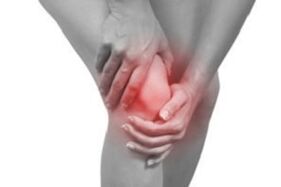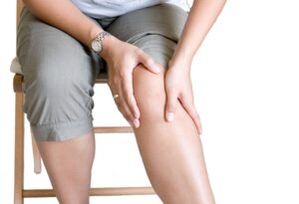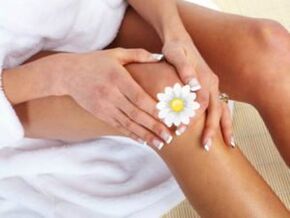
Of all the joints in the human body, knee pain is the most common complaint in humans. The knee joint is hard, it carries a lot of load during different types of physical activity, therefore, there can be many causes of pain in it. Knee pain, even if it sometimes occurs and goes away on its own, should not go unnoticed.
Knee pain, no matter how intense, significantly worsens the quality of life. There is no joy from your favorite outdoor activity, efficiency decreases and a simple shopping trip becomes a problem.
In our article we will discuss what to do if knee joints hurt, how to treat them and whether it is possible to get rid of knee discomfort forever - the last question is especially relevant for the elderly who are discussing sedentary movement and joint pain. The syndrome is an indispensable companion of age.
Pain diagnosis
- It is necessary to clarify the nature of the pain. The pain can be sharp, stinging, aching, painful.
- Eliminate the circumstances of the onset of pain - at night, after exercise, while walking, in the morning, a sudden sharp pain.
- Were there any other signs of joint damage: swelling, hyperemia (redness), joint deformity, convulsions, limited mobility.
- Check for a history of infection, stress, leg injury, or increased physical activity.
- Undergo an instrumental examination at a medical and prophylactic facility (LPU) - blood test, X-ray diagnosis, synovial fluid analysis.
Causes of knee pain
There are more than 200 joint pathologies, most of which are accompanied not only by pain. Only on the basis of a complex of symptoms and examinations can you determine what is causing the knee pain.
Traumatic pathology
Knee pain occurs during traumatic pathologies due to joint damage (blows, falls, prolonged stress on the joints - typical for athletes) or general diseases of the body.
Consider the main traumatic pathologies.
Knee fracture
Patella fracture or displacement, fracture of the femur and / or shin condyles. When falling from a height to the knees, during a car accident, etc. Sh.
The victim experiences sharp sharp pain at the moment of impact, the pain does not stop over time, it may weaken slightly but intensify with pressing or walking.
The joint is swollen, deformed, filled with blood (hemarthrosis), the knee does not bend and the patella becomes abnormally moving.
Dislocated Article

Characterized by the movement of the joint bones relative to each other. Knee joint dislocation is of varying complexity (complete, incomplete, complicated by soft tissue rupture, etc. ).
Usual dislocation occurs as a result of knee injury or a congenital anomaly: weakness of the ligaments or excessive elasticity, flat sliding paths of the thigh at the joint, position of the patella too high.
Knee joint dislocation is a pretty serious injury and if you do not take care of it in time, it can all end in serious complications. Knee joint dislocation is the most painful of all types, although it is a rare occurrence.
Serious injuries, such as dislocations, should be treated in medical facilities, so there should be no independent intervention. This is what traumatologists do.
Stretching, rupture of tendons, ligaments
Depending on the degree of damage (partial rupture of individual fibers, incomplete rupture, complete rupture) symptoms include: convulsions and tingling during movement, bruising below the rupture site, limitation of joint flexion-extension, knee swelling, joint very mobile. (With complete fracture of ligaments). The pain is sharp and severe, but with minor injury it may not appear immediately, but after a period of time.
Bursitis
Inflammation of the periarticular burrow due to trauma, infections, metabolic disorders, autoimmune disease. It is often found in athletes and people with increased weight. The knee is swollen, the pain varies in intensity, but increases during exercise and at night.
Meniscus rupture
May be the result of trauma or degenerative changes in cartilage tissue. Acute trauma is characterized by severe pain, swelling, and limited mobility. The symptoms of degenerative changes are mild.
Diseases of the joints
Knee pain can be a symptom of a medical condition.
We have listedThe most common diseases with knee pain syndrome:
Rheumatism
Diagnosis is much less common than in the 19th and 20th centuries. This is due both to the discovery of penicillin (and then to the production of other antibiotics), as well as to the low diagnostic capacity in the past, when almost all diseases of the joints were attributed to rheumatism.
A characteristic sign of rheumatism is alternating pain in the joints: first one joint is inflamed, then the other. For example, knee pain decreases but appears in another large joint (elbow, thigh).
Rheumatism is more common in children and adolescents, the disease develops after streptococcal infection of the upper respiratory tract.
Note: Developed rheumatism causes damage to the heart (rheumatic heart disease) or the nervous system (chorea).
Reactive arthritis
It is more common in people of reproductive age, since inflammation of the joints is most often caused by pathogenic microbes that enter the human body sexually.
Less commonly reactive arthritis is caused by infections of the gastrointestinal tract or infectious inflammation of the nose and throat (sore throat, flu). 1-4 weeks after the onset of the disease, the patient notices that his legs ache at night.
Both large (knees, ankles) and small joints (big toe hurts or aches) can become inflamed and painful. Knee pain is accompanied by swelling and / or redness.
Sometimes the symptoms are conjunctivitis (inflammation and pain of the eyes), keratoderma (thickening of the skin on the feet).
Reiter Syndrome
Urethritis (frequent, painful urination) and bowel disorders join the symptoms of common reactive arthritis.
Osteoarthritis
Disease of the elderly. Periodically my knees hurt at night "for the weather". Load on the joint (long walk) increases pain, swelling and impedes joint movement.
The pain disappears after resting and warming up.
Baker cyst
Swelling of the back of the knee, which causes a feeling of compression, difficulty in movement.
Disecane osteochondritis (Koning disease)
The bone-covered cartilage exfoliates, the aching knee aches, and when the fragment is completely disintegrated, joint movement is impeded.
Osgood-Schlatter disease
It is more commonly diagnosed in adults. Knee pain increases when climbing and descending stairs, while sitting.
მაevatoid arthritis
An autoimmune disease whose mechanism is unclear. It is observed that the initial circumstances are the usual list of loads on the immune system: from stress and infection, to hypothermia. Immune bodies that attack their own cells cause inflammation of the joint, especially its synovium.
Under the influence of an attack of immune cells, the membrane swells, increases in volume, and then begins to grow in nearby cartilage and bone tissue. The result of the process is pain in the knee joints, which becomes unbearable in the second half of the night.
The disease lasts for years, treatment consists of nonsteroidal anti-inflammatory drugs, corticosteroid hormones, gold preparations, immunosuppressants, anti-malarial drugs.
Arises as a result of improper metabolism. Due to the abuse of alcohol, "purine" products (meat, smoked meat, pickles).
Uric acid produced in the blood is deposited in the joints in the form of sodium urate crystals. Growing "deposits" gradually affect the mobility of the joint, there are strong attacks of pain, the time interval between attacks gradually decreases.
Vascular pain in the knees is characterized by a tingling sensation along the vein, sometimes patients notice a sharp tingling sensation.
Only a doctor, after a detailed examination, can say why the knee hurts if there was no obvious injury. It is unwise to amputate a knee joint with a device that "helped a neighbor. " After all, anything that helps heal a joint injury can exacerbate the autoimmune mechanism of the disease.
Treatment of knee pain
The doctor chooses the treatment regimen according to the diagnosis.
Therapeutic measures are aimed at combating:
- Causes of the disease - infection, cancer, abnormal metabolic processes, immune system failure.
- Pain syndrome - symptomatic treatment includes analgesics, intra-articular blockades.
- With degenerative processes - preparations with chondroprotectors help to restore the cartilage tissue of the joint.
If necessary, resort to surgery, endoprosthesis, use physiotherapy and joint healing exercises.
Analgesic products
Checklist for those with knee pain - what to do to alleviate the condition.
| Cause of pain | What should I do |
|---|---|
| The pain is clearly caused by the injury | Ensure immobilization of joints and limbs, ice or cold compresses on the knee. Ambulance. |
| Pain during arthritis (reactive, rheumatoid, etc. ) | Specific treatment with antimicrobial and anti-inflammatory drugs is prescribed only by a doctor. For night pains you can apply a warming compress, ointments based on bee venom. |
| Pain in osteoarthritis (post-traumatic, age-related, overweight people) after exercise or at night | Lubricate any warming compresses with herbal tincture, chondroprotectors in ointments. |
Severe joint pain is relieved by nonsteroidal anti-inflammatory drugs (NSAIDs).
But most patients (overweight, age-related changes in the joints) will not have to think about what to do with the pain if they follow a prophylactic minimum:
- Proper nutrition with sufficient amounts of calcium, vitamins, fight against excess weight;
- Reduce severe stress on the joint before changing jobs if it consists of "standing up" all day;
- Systematic physiotherapy to strengthen muscles and ligaments - a good muscle corset reduces the load on the bones;
Joint diseases can develop over years and lead to a significant deterioration in quality of life. A timely visit to the doctor and an arsenal of folk remedies will help you maintain the joy of movement in old age.
Joint treatment at home - folk recipes
Homemade recipes for ointments and compresses based on natural ingredients are used in the courses - this is the only way to achieve long-term results.
7 Simple Folk Remedies For Knee Pain:
- Cabbage leaves. Cut the fresh leaf so that the juice comes out. Put a spoonful of honey in the middle and apply this "compress" on the knee. The sheet is fixed with a bandage. Wear a bandage all day or do the procedure at night.
- Propolis tincture in arthritis. If the knees "turn" at night (dull pain can be caused by weather changes to stress on the feet), lubricate the joint with the mixture, massage into the skin until it dries. Wrap a scarf. The tool is also used to warm the joint if the sore knee is cold. Likewise, use tinctures from natural stimulants: aloe, kalanchoe, mummy, bee sting.
ᲛImportant:Biologically active substances should not be used if the disease is autoimmune in nature. Stimulants activate the immune system and aggravate the disease.
- Gelatin compress. Squeeze a piece of gauze soaked in hot water, pour 1 tbsp in the center. Gelatin, apply to the joint, wrap in food foil and wrap. Repeat the procedure overnight for 14 days. The product promotes joint nutrition and cartilage regeneration.
- Mustard compress will help you if your knee hurts a lot. Take honey and dry mustard in equal proportions, add warm water and salt until a grill consistency is formed. Lubricate the knee with the mixture, cover the canvas with tape and a bandage. Exposure time 20-40 minutes. , Remove in case of strong combustion. Mustard compress is used for pain every other day.
- To prevent sore feet, prepare a medicine for oral administration: gelatin is mixed in 0. 5 liters of water in the evening, heated in the morning until it is completely opened. The mixture is taken before meals ¼ - 1/2 cup, drink for a month.
- Internal goat fat (100 g) is mixed with "Zvezdochka" balm (1 can), rub the ointment obtained during venous and joint pain in the knee.
- Kefir mask. 0, 5 liters of crushed kefir bread, add 1 tsp. K. Soda. Insist the mixture for 6 hours. The liquid is then filtered, moistened with gauze and compresses are made for a few days until the pain disappears.

It is advisable to regularly apply home remedies with folk remedies, along with traditional medicine and modern methods. Do not wait until the disease is already firmly established and pronounced severe pain, joint deformity. An early visit to the doctor will accelerate recovery, while the chronic form of the disease is more difficult to cure.
ᲨNote:Treatment with folk remedies is allowed only with the consent of a doctor, after examination and diagnosis.

















































